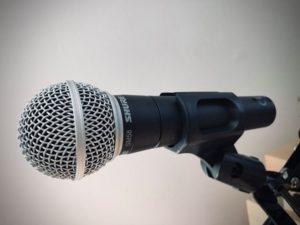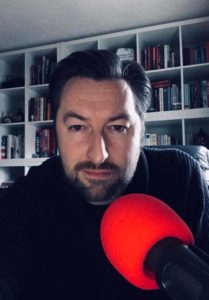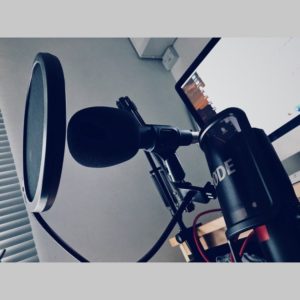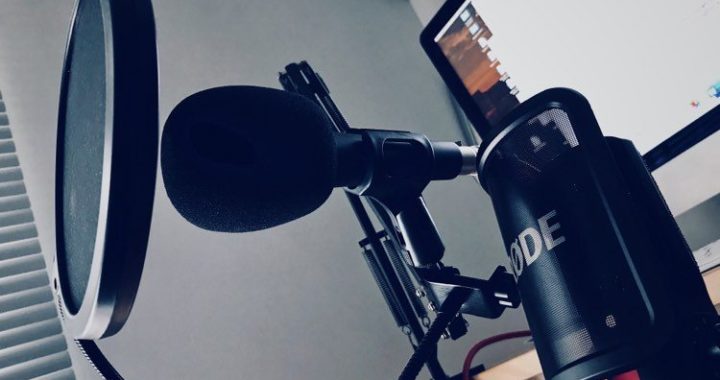We’ve teamed up with podcasting expert Chris Carr to offer a new podcasting service…
What is a podcast?
It’s best to think of a podcast as like an independently made radio show.
Podcasts started out as audio only shows via Apple Podcasts and they have grown into one of the biggest and most exciting areas of content creation.
Podcasts can include video, though there are more technical aspects to consider if you go down a video route.
 How does a podcast work and reach an audience?
How does a podcast work and reach an audience?
Giving you an overview of the process, you record your podcast, whether it be a chat, an interview or series of interviews. It’s then edited and given a sound mix (Which can be done by you or by a hired professional). Once the edit is completed the final MP3 file gets uploaded to a hosting platform such as Audio Boom. That platform then pushes your show out to podcast apps such as iTunes, Spotify, Podbean, etc
When starting a podcast there are things to think about
- Style of show
- Frequency of release (You need to be consistent in releasing to build an audience). It’s recommended to start small, build a loyal audience and work your way up as your audience numbers increase. There is much debate about frequency and statistically speaking weekly shows do generate the biggest audience numbers, but many shows started monthly and grew too weekly. Some podcasts are daily, news type shows, etc. But that is a huge commitment of time and you’ll need decent income to come in for it to be sustainable)Goal of the podcast – what is it?
- Be careful in wanting to chase numbers as it can take most podcasts without a celebrity attached between 2-5 years to get a large following
- What is your niche/angle?
- How long should your podcast be? (30min or less is very popular, though the biggest and most successful podcasts can be over an hour per episode.)
Commitment / Balance of life
- Are you a podcaster first and something else second? Or are you something else first and then a podcaster? – Answering this question honestly will help you determine the frequency of shows and the commitment you want to make.
- Start small and be reliable is a good recipe for success
- If the show starts making mega bucks it could change your career path and you may have to make some choices with regard to that.
- Many technical and time-consuming aspects can be outsourced to professionals. If this is your goal you will need to budget for that.
Guests/Co-Hosts
- The quality of guests and co-hosts have the biggest effect on your audience numbers.
- Generally speaking, podcast listeners tend to consider the personality of podcast host or hosts more important than the content.
- High profile guest or co-hosts do boost your audience numbers.
- The most successful podcasts (numerically speaking) tend to be fronted by celebrities or high-profile experts in the topic the podcast is about.
- Niche topics do bring in niche and loyal audiences.
Sound Quality
Podcast audiences tend to be more forgiving than broadcast audiences. That maybe because podcasts started out as home made content. That said, if your audio is difficult to listen to it can be a huge turn off. So, your goal from a technical perspective is to get the best and clearest audio you can on a consistent basis. That means you will have to create a workflow from recording through to postproduction.
Recording a podcast
Once you have worked out the style and format of the show, you will need to record it. Like with getting a coffee there are many choices that can affect the flavour of your final podcast.
Studio Recording
A sound studio offers the highest quality sound because nothing beats an aquatically treated room. Just ask any radio station or audio engineer. It doesn’t have to cost the earth to use a studio as there are good deals for local podcast studios. You can even build your own home studio if you have the money and the space.
When renting a studio, aside from cost you need to factor in time for the recording and getting to and from the studio. Also, you will need to work around studio availability, which can present challenges. So, you need to consider these things.
Remote Recording
Remote recording has its advantages and disadvantages depending on the style of show you wish to make and also the realities of the Covid 19 world we currently live.
You can get a good sound in a quiet room and with the power of the internet you can speak to anyone anywhere in the world. This could be helpful for interview-based shows, as flying in an expert or waiting for them to be in town can be a big issue for you. Also, if you host a chat style show, connecting online is a lot less of a time commitment than all of you going to a studio.
There are things you can do to make your remote recording set up sound great.
Avoiding empty and bare rooms is a must as they create echo or reverb (as audio engineers like to call it). Reverb washes out your sound and makes everything sound distant and tinny. So that is the main thing you want to avoid. The other thing to consider is local noise. If you live in a very noisy location you may find in an unsuitable place to record or you may need to invest in small, personalised recording spaces that are installed in your home, such as a Whisper-booth. But that is really in an extreme situation.
Local recording
Local recording is when each person has a mic and an audio recorder with them. Sound is then synchronized in post and you are only the internet or phone to run the conversation. The recording of the chat is done by your audio recorder. Local recording is an expensive option, but it is more reliable as it doesn’t rely on the internet, and the audio is better quality due to the higher file sizes and preamps in the recorder.

Video
There are many ways to include video as part of your process.
Waveform videos
The most popular style at the moment is to create a “waveform” video. A waveform video is created by adding your podcast artwork to your existing audio as the visual element. A waveform (a squiggly line that reacts to sound) is then added to create movement to the video, and this is then uploaded to YouTube.
Webcam Videos
This is I which you record the webcam footage of each speaker and edit it together. Personally, it’s my least favourite option as I think it looks ugly, but there are things you can do to jazz up your webcam footage.
Have the camera level with each speaker. There is nothing worse than a low camera angle looking up at someone. It’s very unflattering. Make sure the background is not messy. You will need consistent lighting, as web cameras change their exposure with shifting light, and you don’t want to end up in silhouette. Also, it will be good to consider you appearance, wardrobe, hair, make up, etc.
You can use a DSLR instead of your computer camera which will result in a betterlooking image. There are gadgets that allow you to hook up your DSLR to a webbased conversation.
Third Person Video
So, this is when each person is filmed by an operated or remote camera from a fixed position that is not connected to the computer. It makes your podcast suddenly look like a news item or a documentary. This is the style of popular podcaster Joe Rogan (Not that I am a fan of his podcast). Aesthetically it looks muck slicker, especially with nice lighting and choices of lenses, camera equipment and location.
One major thing to consider with any video option is the microphone you use. Most podcast mics sit in front of the speakers face, that is because it is the best position for optimal recording. However, that may not look so good on camera. Some podcasters have embraced that look, and that is a choice. But if you do want to go down the video route and not have a mic in your face, you will need to look into boom mics and lapel mics that are not seen on camera. These have a different quality of sound, but if done right they can sound just as good for both the audio and video side of your podcast. So, it is worth considering this as early as possible as you may have to invest in a different set of equipment.

Equipment
A basic set remote up for audio only podcasts…
- USB Mic per speaker
- Pop Filter for mic
- Stand for mic
- Reliable computer – this is a must, if your computer is old and buggy it will affect recordings
- A reliable broadband connection – Really a must for remote recording (Though a work around for that is local recording)
For higher quality sound
We recommend local recording for hosts (and guests where possible)
- XLR mic
- interface for computer (if you still want to go via computer)
- Audio recorder – local recording
- Acoustic treatment of recording location – could be adding soft furniture, investing in acoustic foam, isolation shield for mic
Audio equipment for Video that doesn’t feature the mic
- Shotgun mic (per person)
- Boom arm and c-stand (per mic)
- A multichannel Audio Recorder
Promoting the podcast
Social Media
It’s important to have a social media presence. If you are fully on it, you can create assets for all platforms (though it is time consuming and can be expensive). If you don’t have time for all platforms pick the one that works best for you and master that.
Key Social Media
- TikTok
- YouTube
Revenue
You can make money from your podcast, though it can take time to make significant money and generally the rule of thumb is you ideally need 10,000 unique listens per month to start making money via advertisement. Another very popular way to make money is building a loyal subscriber base via Patreon. Patreon allows you to build an audience and create exclusive content for that audience. Though creating that exclusive content is an extra commitment, but it could be worth it. Look at the success of the podcast “Mueller She Wrote”. They have over 4,000 monthly subscribers with paid membership ranging from $3 – $85. At the very minimum they are making $12,000 per month. (Most likely they are making more than that)
- Patreon – get paying supporters for your podcast – Idea is you create tiers that has separate exclusive bonus content for each tie
- Advertisement – I highly recommend hosting with Audio Boom as they make it super easy to get advertisement. When you hit roughly 10,000 listens per month you qualify for advertisement
- YouTube – Get on YouTube. Once you have over 1000 followers you can generate revenue via advertisement
- Merchandise – There are service such as Red Bubble in which you can create and sell merchandise for your podcast
- Books – Many people transcribe their podcasts and turn them into books “How to fail” is a good example.
Contact us to talk further about podcasting and find out how we can help you get up and running with one!
